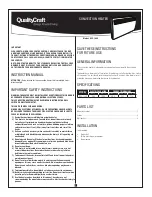
6 Maintenance and service
User reference guide
19
RGSQH10S18AA9W
ROTEX HPU ground
4P374247-1 – 2014.03
Tips about leaving water temperature
▪
In heating mode, a lower desired leaving water temperature
results in lower energy consumption and better performance.
▪
Set the desired leaving water temperature in accordance with the
heat emitter type.
Example:
Underfloor heating is designed for
lower leaving water temperature than radiators and heat pump
convectors.
Tips about DHW tank temperature
▪
Make sure the number (available hot water for x persons) on the
DHW tank temperature home page is NOT higher than your actual
needs.
▪
Use a weekly schedule for your normal domestic hot water needs
(only in scheduled mode).
▪
Program to heat up the DHW tank to a preset value (Storage
comfort = higher DHW tank temperature) during the night,
because then space heating demand is lower and electric tariffs
may be lower.
▪
If heating up the DHW tank once at night is not sufficient,
program to additionally heat up the DHW tank to a preset value
(Storage eco = lower DHW tank temperature) during the day.
▪
Make sure the desired DHW tank temperature is NOT too high.
Example:
After installation, lower the DHW tank temperature daily
by 1°C and check if you still have enough hot water.
▪
Program to turn ON the domestic hot water pump only during
periods of the day when instant hot water is necessary.
Example:
In the morning and evening.
6
Maintenance and service
6.1
Overview: Maintenance and
service
The installer has to perform a yearly maintenance. You can find the
contact/helpdesk number via the user interface.
As end user, you have to:
▪
Keep the user interface clean with a soft damp cloth. Do NOT use
any detergents.
▪
Regularly check if the water pressure indicated on the manometer
is above 1 bar.
Refrigerant
This product contains fluorinated greenhouse gases covered by the
Kyoto Protocol. Do NOT vent gases into the atmosphere.
Refrigerant type: R410A
Global warming potential value: 1975
Periodical inspections for refrigerant leaks may be required
depending on the applicable legislation. Please contact your installer
for more information.
6.2
To find the contact/helpdesk
number
Go to [6.3.2]:
> Information > Error handling > Contact/helpdesk
number.
7
Troubleshooting
7.1
Overview: Troubleshooting
If a malfunction occurs, is displayed on the home pages. You can
press
to display more information about the malfunction.
For the symptoms listed below, you can try to solve the problem
yourself. For any other problem, contact your installer. You can find
the contact/helpdesk number via the user interface.
7.2
To check the error history
Go to [6.3.1]:
> Information > Error handling > Error history.
7.3
Symptom: You are feeling too cold
(hot) in your living room
Possible cause
Corrective action
The desired room temperature is
too low (high).
Increase (decrease) the desired
room temperature.
If the problem recurs daily, do
one of the following:
▪
Increase (decrease) the room
temperature preset value.
▪
Adjust the room temperature
schedule.
The desired room temperature
cannot be reached.
Increase the desired leaving
water temperature in accordance
with the heat emitter type.
7.4
Symptom: The water at the tap is
too cold
Possible cause
Corrective action
You ran out of domestic hot
water because of unusual high
consumption.
If you immediately need domestic
hot water, activate the DHW tank
booster mode. However, this
consumes extra energy.
If you can wait, overrule
(increase) the active or next
scheduled desired temperature
so that more hot water will be
produced exceptionally.
If the problems recurs daily, do
one of the following:
▪
Increase the DHW tank
temperature preset value.
▪
Adjust the DHW tank
temperature schedule.
Example:
Program to
additionally heat up the
DHW tank to a preset value
(Storage eco = lower tank
temperature) during the day.
The desired DHW tank
temperature is too low.






































